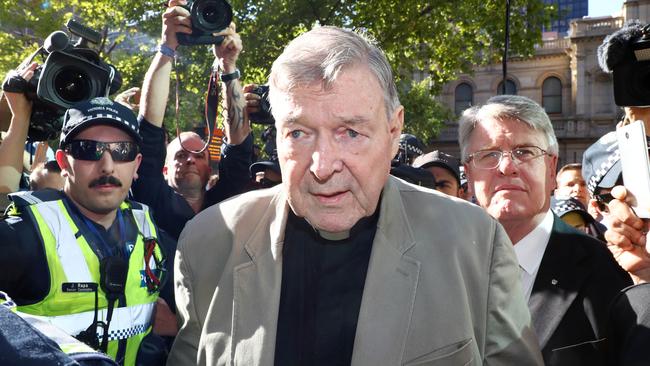Pell’s sentence will deepen rift

The Pell trial and verdict have deeply divided the community and the sentencing process is likely to exacerbate this. The case will highlight many of the shortcomings of the sentencing system, not the least of which is the profoundly impressionistic and discretionary nature of the decision-making process. On the basis of today’s approach to it, the cardinal could be sentenced to anything from no prison time to (a non-parole period of) six years.
The reason for the broad sentencing range stems from the fact that it is effectively up to the discretion of the judge how much emphasis he places on any particular sentencing consideration. And in the Pell matter there are a large number of established sentencing factors, many of which point in different directions as far as sentence severity is concerned.
The offence of sexual penetration of a child under 16 and four offences of an indecent act with a child under 16 of which Pell was convicted are aggravated by the fact that they involved a considerable abuse of trust. Also, given that Pell pleaded not guilty, he will not be entitled to a discount (of about a quarter) that he would have received if he had not contested the charges.
There are also mitigating factors. Pell would experience harsher than normal prison time due to his age, poor health and the likely need to be kept in protective custody. He has an unblemished record, uniquely impressive character references and has made a significant contribution to the community. The weight of sentencing law suggests the shame he has experienced as a result of the convictions will also reduce the penalty. Indeed the hostility directed at Pell as he entered and left court is unprecedented in recent Australian history.
The calculus that the sentencing judge is required to perform is made all the more complex and opaque by the fact the offences occurred more than 20 years ago, and the sentence that is imposed will essentially need to reflect sentencing standards at that time. Sentencing practices more than two decades ago failed to reflect the enormous damage caused by sexual offending against children.
Victimology studies demonstrate the lives of many people are ruined as a result of being victims of child sexual abuse. Sentencing practices in Victoria give far too little weight to this. Rarely do offenders of these crimes receive sanctions that match the seriousness of their deeds. It was not until last year that the High Court, in DPP v Dalgliesh, briefly referred to the evidence regarding the devastating impact of child sexual offences and stated that sentences were too low; that said, penalties for child sexual offences still do not adequately reflect the gravity of such offending.
The penalties for child sex offences two decades ago were breathtakingly lenient. The most accurate relevant publicly available data goes back to the years 2001-02 to 2005-06, and shows that only 44 per cent of offenders in Victoria were given a custodial (which includes imprisonment, partially suspended sentence and a youth training centre order) for the offence of sexual penetration of a child aged between 10 and 16.
This is Pell’s most serious offence. The maximum non-parole period was six years and two months. For indecent assault of a child under 16, some 51 per cent of offenders received a jail term. The crimes of which Pell were convicted occurred around 1996, and during this period (anecdotally at least) courts were even softer on child sex offenders.
While Pell has been convicted of five offences, the principle of totality requires that if prison terms are imposed, most of them should be served concurrently.
So, what penalty will the judge impose? The unfortunate reality is that consistent with the conventional approach to sentencing decision-making, tenable reasons can be crafted to explain a sanction within an enormous range.
A penalty at the lower end of the spectrum would stress the profound level of shaming that Pell has endured and harsh prison conditions that he would experience. These were among the factors that were relied on by the County Court when, in 2013, it imposed a non-custodial sentence on a magistrate, Simon Cooper, who pleaded guilty to seven offences of sexual assault against two brothers aged between 17 and 18 years at the time of the offences. The offences were also committed about 20 years before the sentencing and the court decided that the appropriate penalty was a fully suspended prison term, meaning Cooper spent not a day in jail.
Quite simply, the court in Pell’s case could reduce the penalty by 5 per cent or 50 per cent because of harsh prison conditions and his public shaming. However, the judge’s decision to remand Pell in custody pending his sentencing is a compelling indication that some sort of custodial term will be imposed.
A penalty at the higher end can be explained in the Pell matter by emphasising the enormous authority of the cardinal and the high level of trust that he breached. The ongoing, unremitting distress caused to the complainants would also be a key focus of any such decision.
The only matter that is certain about the coming Pell sentence is that it will demonstrate the unsatisfactory, opaque nature of sentencing. In legal terms, the decision-making process is termed “instinctive synthesis”. This is simply code for intuition — an utterly inappropriate mechanism for deciding much that is important to the lives of victims and defendants, and the interests of the wider community.
Irrespective of what sanction is imposed, it is likely the public division regarding the legal response to the allegations against Pell will increase; few people are wired to have the same intuitions.
Mirko Bagaric is director of the Sentencing and Criminal Justice Project at Swinburne University of Technology.


